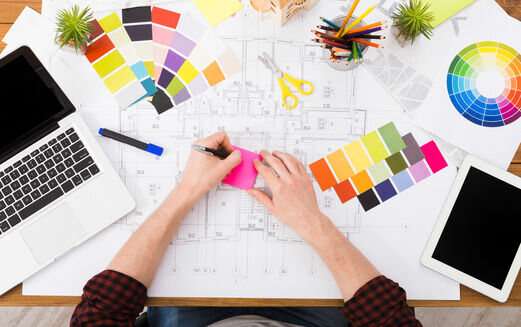Interior design is more than just choosing colours and placing furniture — it’s a thoughtful process that balances beauty, function, and comfort. Whether you’re decorating a single room or revamping an entire property, understanding the 7 basics of interior design is essential to creating spaces that feel cohesive, inviting, and purposeful.
In this guide, we’ll walk you through these foundational principles that every designer — and design enthusiast — should know.
1 . Space
Space is the foundation of any interior design. It refers to the physical boundaries of a room — its length, width, and height. There are two types of space to consider:
- Positive space: Where furniture and décor are placed.
- Negative space: The empty areas that allow the design to breathe.
Balancing these two creates harmony and prevents clutter or emptiness.
2 . Line
Lines define shapes and guide the eye. In interior design, lines are found in architecture, furniture, and accessories. They are categorised into:
- Horizontal lines: Add stability and calmness (e.g., tables, beds).
- Vertical lines: Suggest height and formality (e.g., doors, windows).
- Dynamic lines: Found in curves and diagonals, adding movement and energy.
3. Form
Form refers to the shape of a room’s objects — from structural features to furniture and décor. Forms can be:
- Geometric: Sharp, clean lines (e.g., squares, rectangles).
- Organic: Natural, irregular shapes (e.g., plants, flowing curves).
A well-designed room often uses a blend of both to maintain balance and visual interest.
➡️ See related content: Modern vs. Contemporary: What’s the Difference in Interior Design?
4. Light
Lighting is a vital element that influences mood, functionality, and visual appeal. There are three main types:
- Ambient lighting: Overall illumination of a space.
- Task lighting: Focused lighting for specific activities (e.g., reading).
- Accent lighting: Used to highlight architectural features or artwork.
A layered lighting scheme enhances depth and creates a more atmospheric environment.
5 . Colour
Colour evokes emotion, creates visual connections, and defines style. It can make a space feel larger, warmer, cooler, or more intimate.
Consider:
- Colour psychology (e.g., blues for calm, yellows for energy).
- The 60-30-10 rule to balance dominant, secondary, and accent colours.
➡️ For inspiration: The Complete Guide to Interior Design Trends for 2025
6 . Texture
Texture adds depth and dimension to a space, whether visual (how something looks) or tactile (how it feels). Examples include:
- Soft textures: Cushions, rugs, velvet.
- Hard textures: Stone, glass, metal.
Layering textures makes interiors feel richer and more dynamic.
7 . Pattern
Patterns introduce rhythm, movement, and personality. They can be used in wallpapers, textiles, rugs, and tiles. Like texture, too much pattern can overwhelm, so moderation is key.
➡️ Enhance your design: Furniture Selections — choosing pieces that support the balance of space, form, and texture.
Bringing It All Together
Mastering these 7 basics of interior design empowers you to transform any space with purpose and creativity. Whether you’re styling a home or commercial space, these principles form the core of effective design.
Need expert guidance? At Oraanj Interiors, we help clients turn design ideas into functional, beautiful realities. Reach out today to begin your interior transformation.


